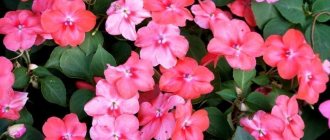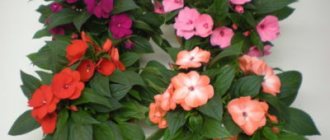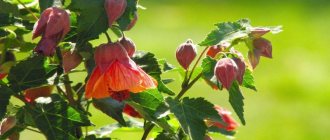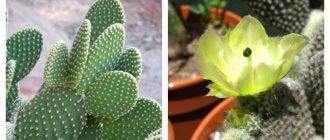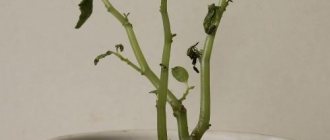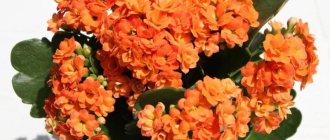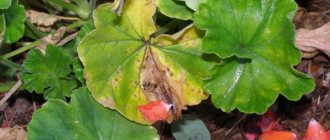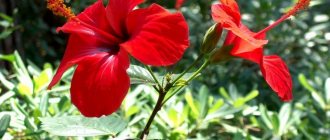Features of the plant
The tropical and subtropical territories of Asian and African countries are considered its native places, but it is also found in Central Asia. Very popular among those who love to grow house plants for the past four hundred years.
Vanka wet reproduces easily. It blooms all year round in different shades - from white to orange. And hybrids are generally unique.
Folk signs about balsam
There are many folk beliefs associated with balsam. Most of them are positive.
- It is believed that balsam planted at home brings good luck and happiness to its owners. There is only one condition - you need to take good and careful care of the flower. As long as Vanka, wet, feels good, peace and tranquility will reign in the family.
- This plant is well suited for rooms with bad energy: if you plant it in a house where a bad event occurred, over time the atmosphere will become calmer. For this reason, balsam is recommended to be planted in large offices, where stress and conflict situations are common.
- Balsam is considered an excellent companion for creative people: according to legend, it helps to reveal hidden potential and gain new interesting ideas.
- This flower is also good for men: thanks to it, you can enhance such masculine qualities as strength, courage, boldness, improve health and gain self-confidence.
Unfortunately, not only good omens are associated with balsam: some superstitious people believe that if you bring Vanka wet into the house, the owner will certainly start drinking.
- Author: iarriba
Rate this article:
- 5
- 4
- 3
- 2
- 1
(5 votes, average: 4.4 out of 5)
Share with your friends!
Home care
Balsam is good because it is not capricious. So even a novice gardener can grow it. But there are still a number of conditions necessary for the beauty, splendor and good flowering of the bush.
Location and lighting
Everbloom develops throughout the year, without a specific dormant period. In order for it to bloom well, it will need a lot of light. But in the summer it is still better to use eastern and western window sills. If the pot is on a south window, be sure to shade your pet. In winter, when daylight hours are too short, use special lamps to extend this period to 12-13 hours. Then you are guaranteed to admire flowers.
Temperature
The degree of environmental warmth is not particularly important for balsam. The optimal mode is from 15°C to 30°C. There should be constant fresh air in the room. Protect impatiens from drafts.
In winter, cardboard or polystyrene foam should be placed under the pots on the windowsills for warmth. Make sure that the thermometer does not fall below +12 degrees.
Watering
There are several ways to water a wet Vanka:
Upper
Soil under the flower until the entire lump is wet. After some time, drain excess moisture from the pan.
Lower
After pouring water into the pan, you must wait until the moisture is absorbed into the soil. Remove excess liquid.
Wick
It is used by flower lovers who are away from home for a long time - on a long business trip, on vacation.
It's not difficult to make. To do this you will need a piece of clothesline. Pass it through the drainage hole of the pot. Fill the flowerpot 1/3 with soil. Lay the twine in a spiral. Lower the flower. Fill with soil mixture to the required level.
Initially, you need to water your pet using the overhead method, then place it over a container of water. Moisture will flow inside through the cord, moistening the entire soil. Fertilizers can be added to the wick watering liquid in a very small dose.
Air humidity
At low temperatures of 15-20°C, balsam does not need air humidification. On the contrary, excess moisture can lead to diseases. But at 20-25°C you will have to moisturize. At 30°C, such a measure is mandatory.
Use a regular spray bottle. It must be remembered that it is undesirable to leave droplets of water on flowers and leaves. When exposed to direct sunlight, spots form in these places, spoiling the appearance.
The best time for the procedure is morning or evening. You can use a special humidifier, which creates a favorable microclimate. The method, of course, is expensive, but it is useful not only for flowers, but also for humans.
The soil
You can plant balsam in commercially available soil: such as “rose”, “violet”. It is considered ready for use, but must be loosened before replanting. For this purpose, washed river sand or perlite is suitable. By adding one of these ingredients, the soil will become loose and airy.
You can prepare the soil mixture yourself with the following composition:
- 25% perlite or sand;
- 75% soil.
Feeding and fertilizers
Impatiens can be fed with any fertilizer for flowering plants. The only exceptions are decorative deciduous ones. They can be different in form:
- in the form of tablets;
- rods.
It doesn't really matter. You need to bury them in the ground; when watered, they will gradually release the required amount of microelements into the soil.
Liquid ones are also used. They need to be fed after watering. Only the next day, otherwise the roots may get burned.
With natural light in the autumn, fertilizing can be reduced. In winter, stop altogether. And return to fertilizers starting in spring. When illuminating in cold weather, exclude feeding for a month or two, giving the impatiens a rest. There is no need for fertilizing after transplantation for 1-2 weeks. Some gardeners do not fertilize the bush at all. At the same time, it is replanted every year in fresh soil.
Transfer
The flower tends to grow and increase the volume of the root system. When the roots become crowded, replanting is required. If possible, you need to wait until spring. The procedure can be carried out by completely replacing the soil or by transshipment.
In the first case, it is necessary to remove all the soil from the roots. You cannot wash them, otherwise the hairs will be washed off and the patient will be sick for a long time. It might even disappear altogether.
When the second time is wet, Vanka is carefully removed from the pot, leaving the soil mixture behind. Place in a larger pot, filling it with additional soil. Do not replant immediately into a container that is too large. The size should increase gradually.
Trimming
The best time for this is spring, when young shoots appear. Pruning prevents the flower from growing larger and makes it look neater. The procedure can be performed up to 1/2 the size of the bush. The material obtained in the process is used for reproduction.
How to form a crown
To obtain a beautiful shape, the top young shoots are removed by pinching. The flower stops growing upward. At the same time, side shoots begin to develop intensively. It is necessary to regularly turn it towards the light to avoid one-sidedness. If there is artificial lighting, then this is not required, because the light source is from above, and the pet will be drawn to it evenly.
How to properly care?
In order for the wet roly-poly to delight you with its appearance all year round, it is important to provide it with the following conditions:
- The air must be fresh.
- The soil must be constantly moist. The top layer of soil should not be allowed to dry out.
- You need to water along the edge of the pot. If water gets on the root collar, the roots and trunk may rot. Drain the water from the pan.
In summer the temperature should be at least + 25 degrees Celsius, and in winter at least + 10 degrees Celsius.- If the temperature is above +22 degrees Celsius, the flower should be sprayed with water. It is important that water does not get on the flowers and buds.
- If necessary, the top layer of soil should be loosened to a depth of 1 cm.
- If a white coating forms on the ground, change the top layer. These are salts that are found in hard water.
- You should always fertilize when the plant is blooming. The choice should be made towards potassium-containing fertilizers.
- In the spring, the flower needs to be replanted, since during the winter it often loses its attractiveness due to the exposed stems. It is important to prune elongated stems in the spring. This does not apply to hybrid varieties, since they branch well on their own. Pinching is needed for:
- getting rid of bare stems;
- improved flowering;
- increasing branching.
Watch a video about caring for balsam:
Bloom
Impatiens flowers delight the eye with their diversity. They really resemble lights (popular name) of various colors: white, pink, orange, red, purple. They are even found with stripes or spots. After flowering, green boxes are formed. They gradually dry out and, if you touch them, burst, throwing seeds out and giving life to offspring.
Amazing flower Vanka wet
The scientific name of the Vanka wet flower is indoor balsam, but it is also called differently: light or impatiens. Although it is considered a tropical crop, some varieties are also found in the wild in the Northern Hemisphere.
Figure 1. The varietal variety of indoor balsams is enormous
First, let's look at the botanical description of the indoor flower. It is usually an annual plant with fleshy stems and elongated leaves with a serrated edge, although some varieties are also cultivated as perennials (Figure 1).
Note: A characteristic feature of the plant is the glossy surface of the leaves. Each plate is covered with a special water-repellent coating, which gives such a visual effect.
First of all, the plant is valued for its decorative value, although traditional medicine experts claim that it also has medicinal properties. However, for most gardeners, Vanka wet is just a beautiful indoor flower with a huge variety of shades of buds, from white and soft pink to rich red.
Reproduction
New plants can be obtained in two ways: cuttings or seeds.
Cuttings
They need to be cut in spring or summer, when they reach about 10 centimeters. To do this, use clean scissors, a blade or a sharp knife. You can root the cuttings in the ground or in boiled water at room temperature.
If you use soil, you need to set up a greenhouse from a bag. When germinating in a container with water, small bottles are used (for medicines). When the first leaves appear, you know: the rooting process has been successful.
Seeds
Propagation material can be purchased or grown at home. The seeds need to be sown evenly into the substrate, watered, sprinkled with a thin layer of soil on top and moistened with a spray bottle.
It is advisable to make a greenhouse out of film. After the sprouts appear, the planting must be ventilated. When one or two pairs of leaves appear, you can start diving. After branching, transplant into separate pots.
Diseases and pests
Like any plant, balsam can be plagued by troubles of the following kind:
| Diseases | Symptoms | Measures |
| Cucumber mosaic - a viral disease | The leaves become wavy, characteristic spots form on them, holes are possible | To be destroyed |
| Ring mosaic is a viral disease | Ring patterns on the leaves, they begin to crack. Growth is slowing down | Must be destroyed |
| Cucumber rot is a fungal disease | The color of the stem changes, it becomes brown | Treatment with Fitosporin |
| Downy mildew is a fungal disease | A whitish coating and spots appear on the leaves | Remove infected areas and treat with Alyet |
| Pests | Symptoms | Measures |
| Spider mite | Yellow specks on the leaves, the appearance of cobwebs | Regular shower with plain water. Preparations: “Actellik”, “Fitoverm”: gentle solution of chamomile or garlic 1/1 |
| Whitefly | The foliage changes shape and turns black | Apply: “Confidor”, “Aktelik”, “Mospilan” |
| Trips | The leaf changes color, shape changes, spots appear | Drugs: Intavir, Vertimek, Fitoverm |
| Aphid | The buds do not open, the leaves curl, the balsam withers | Apply: “Karbofos”, “Fitoverm”, “Kinmiks” |
| Shchitovka | Yellow or brown spots | Remove adult insects with a cotton swab soaked in soapy water and treat with an insecticide. |
| Poduras and fungus gnats | Earth fleas are dangerous for young shoots; they live in the ground | Mix the preparation “Grunt-2” into the soil |
Kinds
There are about five hundred types of balsam and they are divided into perennial and annual:
- annuals - combine those planted in flower beds;
- perennials - those that grow in pots on windows.
Common varieties of balsam in the European part are:
- Walerra's balsam;
- New Guinea;
- garden;
- street;
- festive;
- golden.
There is no need to list all types. The main thing is to decide on the goals and objectives of the design. And then the choice of variety for growing at home will come naturally.
